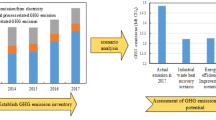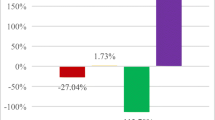Abstract
As one of the most energy-, emission- and pollution-intensive industries, the production of ammonia is responsible for significant emissions of greenhouse gases (GHGs) and local air pollutants. Although many energy efficiency measures have been proposed by Chinese government to mitigate GHG emissions and improve air quality, a less than full understanding of the costs and potentials have been barrier to promoting and implementing these measures. Assessing the costs, benefits, and cost-effectiveness of different energy efficiency measures is essential to advancing this understanding. In this study, a bottom-up energy conservation supply curve was used to estimate the potential of 26 energy efficiency measures in China’s ammonia industry. Their cost-effective implementation results in a potential saving of 271.5 PJ/year for fuels and 5.44 TWh/year for electricity, which equals to 14 % and 14 % of fuel and electricity consumed in the ammonia industry in 2012, and would be responsible for mitigating emissions of annual 26.7 Mt CO2. In addition, the co-benefits of air pollutants emission reductions that result from energy savings were quantified. The results advance the understanding of the cost-effectiveness of energy efficiency measures and can be used to augment the efforts in reducing energy use and environmental impacts.



Similar content being viewed by others
References
Brown D, Sadiq R, Hewage K (2014) An overview of air emission intensities and environmental performance of grey cement manufacturing in Canada. Clean Technol Environ Policy 16:1119–1131
Brunke J, Blesl M (2014) A plant-specific bottom-up approach for assessing the cost-effective energy conservation potential and its ability to compensate rising energy-related costs in the German iron and steel industry. Energy 67:431–446
China Coal Trading Market Website (CCTD) (2012) The trend of coal price in China trading market in 2012. China Railway Publishing House, Beijing (in Chinese)
China Power Yearbook (2013) CO2 emissions analysis of China’s regional thermal power. China Electric Press, Beijing
China Foreign Exchange Rate System (CFETS) (2013) http://www.chinamoney.com.cn/index.html(in Chinese)
China Nitrogen Fertilizer Industry Association (CNFIA) (2013). http://www.cpcia.org.cn/Association/index_x.asp?id=38
CPCY (2013) China petrochemical corporation yearbook 2012. China Building Industry Press, Beijing (in Chinese)
De Schepper E, Van Passel S et al (2014) Cost-efficient emission abatement of energy and transportation technologies: mitigation costs and policy impacts for Belgium. Clean Technol Environ Policy 16:1107–1118
Energy Research Institute (ERI) (2013) Roadmap study on achieving technical energy conservation potential in China’s industrial sector by 2020 (in Chinese). Jiangsu People’s Publishing House, Nanjing
Energy Research Institute (ERI, NDRC) (2013) Potential and cost study on China’s carbon mitigation technologies. China Environmental Press, Beijing
Fleiter T, Daniel F, Worrell E, Wolfgang E (2012) Energy efficiency in the German pulp and paper industry: a model-based assessment of saving potentials. Energy 40:84–99
Fuller S, Petersen S (1996) Life-cycle cost manual for the federal energy management program. US National Institue of Standards and Technology. http://www.google.com.hk/url?sa=t&rct=j&q=&esrc=s&source=web&cd=1&ved=0CB0QFjAA&url=http%3A%2F%2Ffire.nist.gov%2Fbfrlpubs%2Fbuild96%2FPDF%2Fb96121.pdf&ei=HzGSVNLPCYSC8gXNgoLQBQ&usg=AFQjCNGCjvf6Mpg1IJock8g640aTVeWuAw. Accessed 12 Jan 2009
Gu Z (2013) The analysis of China key chemical industry excess capacity. Chem Ind 31(5):1–7 (in Chinese)
Han H (2010) Advancement of China’s ammonia industry. Chem Ind 29(9):1–5 (in Chinese)
Hasanbeigi A, Christiph M, Lynn P (2010) The CO2 abatement cost curve for the Thailand cement industry. J Clean Prod 18:1509–1518
Hasanbeigi A, Morrow W, Sathaye J (2012a) Assessment of energy efficiency improvement and CO2 emission reduction potentials in the iron and steel industry in China. Lawrance Berkeley National Laboratory, Berkeley LBNL-5535E
Hasanbeigi A, Morrow W, Sathaye J (2012b) Assessment of energy efficiency improvement and CO2 emission reduction potentials in the cement industry in China. Lawrance Berkeley National Laboratory, Berkeley (LBNL-5536E)
Hasanbeigi A, Morrow W, Masanet E, Sathaye J, Xu T (2013a) Energy efficiency improvement and CO2 Emission reduction opportunities in the cement industry in China. Energy Policy 57:287–297
Hasanbeigi A, Morrow W, Sathaye J, Masanet E, Xu T (2013b) A bottom-up model to estimate the energy efficiency improvement and CO2 emission reduction potentials in the Chinese iron and steel industry. Energy 50:315–325
Industrial Efficiency Technology Database (IETD) (2014). http://ietd.iipnetwork.org/content/ammonia
International Energy Agency (IEA) (2007) Tracking industrial energy efficiency and CO2 emissions. OECD Publishing, Pretoria, pp 82–83
International Fertilizer Industry Association (IFA) (2014). http://www.fertilizer.org/
IPCC (2007) IPCC guidelines for national greenhouse gas inventory 2006. IGES, Geneva
IPCC (2014) IPCC Annual Report 5: mitigation of climate change, Chapter 10: industry
Islam R, Christoph W, Bianca L (2005) Energy efficiency improvements in ammonia production-perspectives and uncertainties. Energy 30:2487–2504
Jean-Christian B, Markus B (2014) Energy conservation measures for the German cement industry and their ability to compensate for rising energy-related production costs. J Clean Prod 82:1–18
Jia L (2012) Consumption and prediction of ammonia and its downstream industries in China. Chem Ind 30(1–2):38–41 (in Chinese)
Kong L, Hasanbeigi A, Lynn P (2013) Analysis of energy-efficiency opportunities for the pulp and paper industry in China. Lawrance Berkeley National Laboratory, Berkeley (LBNL-6107E)
Laitner J, Ruth M, Worrell E (2001) Incorporating the productivity benefits into the assessment of cost effective energy savings potential using conservation supply. Lawrence Berkeley National Laboratory, Berkeley
Li Y, Zhu L (2014) Cost of energy saving and CO2 emissions reduction in China’s iron and steel sector. Appl Energy 130:603–616
Ma D, Hu S, Zhu B, Jin Y (2012) Carbon substance flow analysis and CO2 emission scenario analysis for China. Clean Technol Environ Policy 14:815–825
Madanhire I, Mugwindiri K, Mbohwa C (2014) Enhancing cleaner production application in fertilizer manufacturing: case study. Clean Technol Environ Policy 16:957–970
Nand S, Manish G (2008) Recent efforts in energy conservation in ammonia and urea plants. Indian J Fertil 4(12):17–20
National Bureau of Statistics (NBS) (2013) China energy statistical year book 2013. China Statistic Press, Beijing, China (in Chinese)
National Development and Reform Commission (NDRC) (2008) National extension directory of important energy conservation technology 1. China Statistical Publishing House, Beijing (in Chinese)
National Development and Reform Commission (NDRC) (2009) National extension directory of important energy conservation technology 2. China Environmental Science Press, Beijing (in Chinese)
National Development and Reform Commission (NDRC) (2011a) national extension directory of important energy conservation technology 3. Guangming Daily Press, Beijing (in Chinese)
National Development and Reform Commission (NDRC) (2011b) National extension directory of important energy conservation technology 4. OECD, Paris (in Chinese)
National Development and Reform Commission (NDRC) (2012) National extension directory of important energy conservation technology 5. World Scientific, Beijing (in Chinese)
National Development and Reform Commission (NDRC) (2013) National Extension Directory of Important Energy Conservation Technology 6. Oxford University Press, New York (in Chinese)
Qian B (2007) New catalyst for the energy saving and emission reduction of China’s ammonia industry. Larg Scale Nitrogenous Ferterlizer Ind 16:78–80
Ren X, Zhang W (2007) New progress for non-power ammonia recovery technology and its application. Chem Fertil Design 45(2):49–51 (in Chinese)
Saidur R, Mahlia T (2011) Impacts of energy efficiency standard on motor energy savings and emission reductions. Clean Technol Environ Policy 13:103–109
The Ministry of Industry and Information Technology (MIIT) (2012a) The advanced technology catalog of energy conservation and emission reduction in petrochemical industry. General Administration of Press, Guangzhou (in Chinese)
The Ministry of Industry and Information Technology (MIIT) (2012b) The minimum energy performance standard for ammonia industry in China. China Statistical Publishing House, Beijing (in Chinese)
Vandecasteele C, Caneghem J, Block C (2007) Cleaner production in the flemish chemical industry. Clean Technol Environ Policy 9:37–42
Wang Y (2013) The analysis of ammonia industry promotion in China. Chem Ind 31(6):34–37 (in Chinese)
Wen Q (2012) The development of China’s ammonia industry. Chem Ind 30(10):16–19 (in Chinese)
Wen Z, Meng F, Chen M (2014) Estimates of the potential for energy conservation and CO2 emissions mitigation based on Asian-Pacific Integrated Model (AIM): the case of the iron and steel industry in China. J Clean Prod 65:120–130
William RM, Hasanbeigi A, Sathaye J, Xu T (2014) Assessment of energy efficiency improvement and CO2 emission reduction potentials in India’s cement and iron & steel industries. J Clean Prod 65:131–141
Wina G (2009) Eliane B (2009) Global technical potentials for energy efficiency improvement. Entrep Theory Pract 33(1):241–276
Worrell E, Blok K (1994) Energy savings in the nitrogen fertilizer industry in the Netherlands. Energy 19(2):195–209
Worrell E, Laitner J, Ruth M, Finman H (2003) Productivity benefits of industrial energy efficiency measures. Energy 28(11):1081–1098
Xu T, Sathaye J, Christie G (2010) Development of bottom-up representation of industrial energy efficiency technologies in integrated assessment models for the iron and steel sector. Lawrence Berkeley National Laboratory, Berkeley
Xu T, Sathaye J, Klaas K (2013) Sustainability options in pulp and paper making: costs of conserved energy and carbon reduction in US. Sustain Cities Soc 8:56–62
Zhang C, Chen J, Wen Z (2012) Assessment of policy alternatives and key technologies for energy conservation and water pollution reduction in China’s synthetic ammonia industry. J Clean Prod 25:96–105
Zhao B, Wang P, Ma J, Li W (2012) A high-resolution emission inventory of primary pollutants for the Huabei region, China. Atmos Chem Phys 12:481–501
Zhou W, Zhu B, Li Q (2010) CO2 emissions and mitigation potential in China’s ammonia industry. Energy Policy 38(7):3701–3709
Zhu B, ZhouW HuS (2010) CO2 emissions and reduction potential in China’s chemical industry. Energy 35(12):4663–4670
Acknowledgments
The first author is indebted to China Scholarship Council (CSC) for financially supporting for his research at Lawrence Berkeley National Laboratory (LBNL). This paper benefits from research supported by the MOE project of Key Research Institute of Humanities and Social Science at Universities (12JJD630002), the Ministry of Science and Technology of China (2012BAC20B01), and the China Sustainable Energy Program of the Energy Foundation. The authors would like to thank the following experts (Su Jianying from CNFIA, Guo Shiyi from MIIT, and Tongqing from Tsinghua University) for their questionnaire feedbacks and valuable comments on this research.
Author information
Authors and Affiliations
Corresponding author
Rights and permissions
About this article
Cite this article
Ma, D., Hasanbeigi, A., Price, L. et al. Assessment of energy-saving and emission reduction potentials in China’s ammonia industry. Clean Techn Environ Policy 17, 1633–1644 (2015). https://doi.org/10.1007/s10098-014-0896-3
Received:
Accepted:
Published:
Issue Date:
DOI: https://doi.org/10.1007/s10098-014-0896-3




